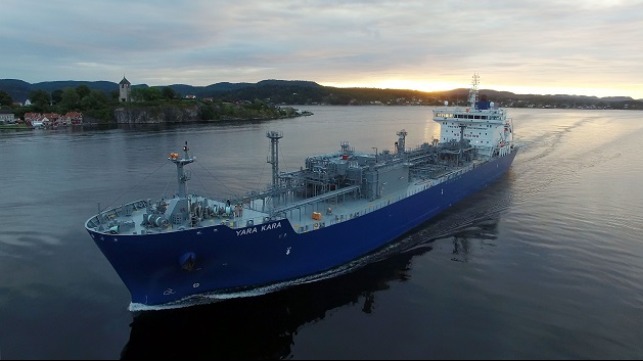Trafigura and Yara Join Forces to Market Ammonia as a Bunker Fuel

Fuel trader Trafigura and ammonia fertilizer manufacturer Yara International have joined forces to collaborate on the development of the use of ammonia as a marine fuel and to explore ways to partner on green and blue ammonia fueling infrastructure. Ammonia is seen by many industry players as the likeliest (or one of the likeliest) components of the industry's move away from fossil-fuel bunkers.
Under the MoU announced today, Trafigura and Yara intend to collaborate on the supply of clean ammonia by Yara to Trafigura; exploration of joint R&D initiatives for clean ammonia application as a marine fuel; and development of new clean ammonia assets, including marine fuel infrastructure and market opportunities.
“This agreement is another good example of cross-industry collaboration to develop and promote zero-emission fuel in the form of clean ammonia for the shipping industry. Building clean ammonia value chains is critical to facilitate the transition to zero emission fuels by enabling the hydrogen economy – not least within trade and distribution where both Yara and Trafigura have leading capabilities. Demand and supply of clean ammonia need to be developed in tandem,” says Magnus Krogh Ankarstrand, President of Yara Clean Ammonia.
Trafigura has also co-sponsored the R&D of MAN Energy Solutions’ ammonia-fueled engine, has performed several studies of transport fuels with reduced greenhouse gas emissions, and has published a white paper on the need for a (very substantial) global carbon levy for shipping fuels.

that matters most
Get the latest maritime news delivered to your inbox daily.
“There is a growing consensus that hydrogen-based fuels will ultimately be the shipping fuels of the future, but clear and comprehensive regulation is essential,” said Jose Maria Larocca, Executive Director and Co-Head of Oil Trading for Trafigura.
Yara makes about 8.5 million tonnes of ammonia a year, and it owns or charters 11 ammonia carriers, along with 18 marine terminals for handling ammonia at ports around the world. This kind of transport and storage infrastructure will be required on an enhanced scale if ammonia gains traction as a marine fuel. It has also recently created a new clean-ammonia division to seize new commercial opportunities in zero-carbon shipping and carbon-free fertilizers.
